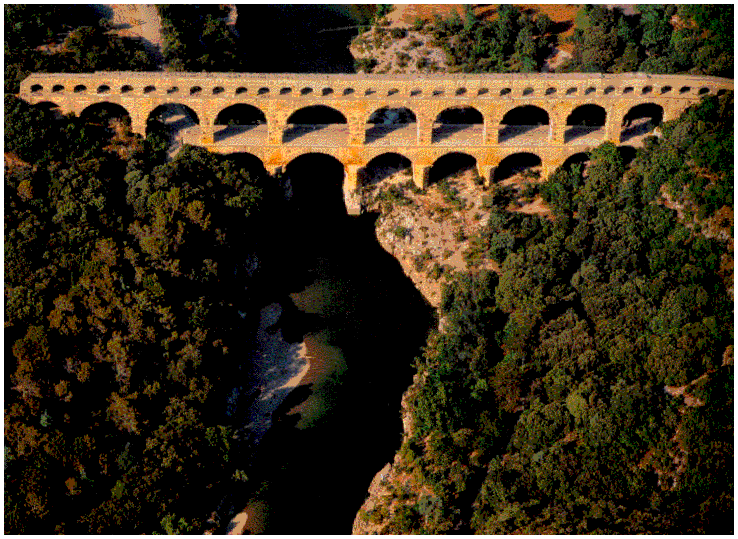
The Past
From Above
Aerial Photographs of
Archaeological Sites
Georg Gerster
Charlotte Trümpler,
Editor
(The J. Paul Getty Museum)

Almost 250 archaeological sites are pictured here, in full color, from above. Some are startling ... such as the 2,000 year old Pont-du-Gard of France [Fig. 1] or the astounding collection of temples at Angkor Thom, Cambodia, dating from 700 years ago. Each full-page full color photograph is given a 300 word run-down, along with a list of books or monographs that can be consulted for further information.Some of these sites look like they belong on the moon, such as a "spring cone" from Iran. As far as we can tell, the verbal description may have come from another planet, too:
[It] rises up from a stony calcareous sinter plateau 3km from Takht-i Suleiman ('Solomon's Throne', no. 18) .... The crater provides a textbook example of what the spring lake of Takht-i Suleiman, which may have come into existence after it, looks like from the inside.
Some of the more famous artifacts of the past don't look like they merit our time or attention. Stonehenge looks like the 18th hole of the National Golf Club at Augusta, while Morocco's ruins at Lixus appear like curlicues made by beach buggies on Padre Island. It might be the height of the plane, the balloon, the glider or the wings that were used to make the shot possible. It could be the angle, or, as important, the hour of the day that the photograph was taken.
The Omayyad Palace looks to be a couple of grain silos from Omaha turned sideways and planted on the ground, but it becomes impressive if not mysterious because of the late-afternoon colors and shadows cast by a dying sun. At the same time, the sanctuary at Sanxay, France from the second century --- beautiful if you are on the ground --- appears not so different from what you might see flying over Eupora, Mississippi on a hot summer afternoon.
There are many of these pictures, however, that are worth writing home about, if not visiting. The Great Wall of China is just that: a great, stark, wild snake crossing a viciously inhospitable countryside. And in the final part of the catalogue, under "Mysterious Grandeur," we come upon [Fig. 2] a wild man, planted on a hillside, complete with club and improbable stony erection. He is to be found at Cerne Abbas, Dorset, England. The notes explain that no one really knows what the hell this maybe 300-year-old, maybe 1,800-year-old figure is all about, although, no kidding, the text suggests that it might have something to do with fertility, and couples who wanted babies were said to have joined forces on the mammoth ridge of the membrum vitale to insure an appropriate outcome.
An unexpected bonus in The Past from Above are the chapter headings, complete with sardonic quotes. Chapter Six, "Frontier Walls to Keep People Out (and In) --- Limes Pursuing Politics by Other Means --- Battlefields" comes with two mots. One is from Herodotus:
Peace is the time when sons bury their fathers. War is the time when fathers bury their sons.
And this one comes from the omnipresent Anon:
A war leaves behind it three armies in a country: an army of cripples, an army of mourners, and an army of thieves.
--- Phyliss Hawthorne, MA